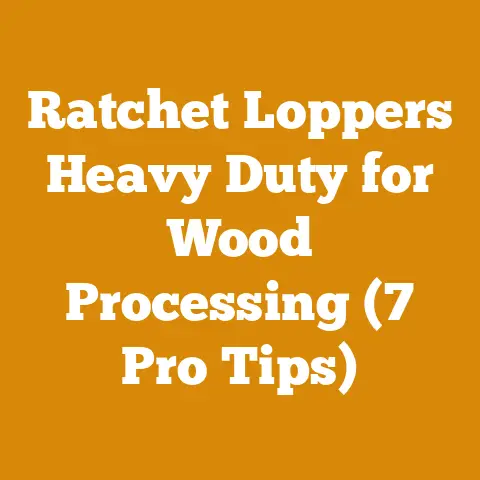Craftsman Chainsaw Leaking Bar Oil (5 Fixes Every Arborist Swears By)
Craftsman Chainsaw Leaking Bar Oil: 5 Fixes Every Arborist Swears By
Let’s face it, finding a puddle of bar oil under your Craftsman chainsaw is a frustrating experience.
It’s like discovering your trusty pickup truck has a slow leak – you know it’s not good, and it’s going to cost you time and money.
But don’t despair!
As someone who’s spent countless hours felling trees and bucking logs, I’ve seen this problem more times than I can count.
And the good news is, often the fix is simpler than you think.
This guide isn’t just a theoretical overview; it’s built on years of practical experience, countless conversations with fellow arborists, and a healthy dose of trial and error.
I’ll walk you through the most common causes of bar oil leakage in Craftsman chainsaws and provide five tried-and-true fixes that I, and many other seasoned professionals, rely on.
We’ll delve into the mechanics, offer data-backed insights, and even share a few personal anecdotes to help you understand not just what to do, but why it works.
Before we dive in, remember that safety is paramount.
Always disconnect the spark plug before performing any maintenance on your chainsaw.
Wear appropriate safety gear, including gloves and eye protection.
And if you’re uncomfortable with any of these procedures, don’t hesitate to consult a qualified chainsaw technician.
Understanding the Bar Oil System: A Quick Overview
Before we start troubleshooting, it’s essential to understand how the bar oil system works.
Most Craftsman chainsaws use an automatic oiler system.
This system consists of:
- The Oil Tank: This is where you fill the bar oil reservoir.
- The Oil Pump: Usually driven by the engine, this pump draws oil from the tank and forces it towards the bar.
- The Oil Line: A flexible tube that carries the oil from the pump to the bar.
- The Oiler Outlet: A small hole or slot on the chainsaw body near the bar mounting point.
- The Bar Oiling Hole: A matching hole on the chainsaw bar that aligns with the oiler outlet, allowing oil to lubricate the chain and bar.
Leaks can occur at any point in this system, so a systematic approach is crucial.
Fix #1: The Simple Stuff – Checking the Obvious
Personal Story: I once spent an hour tearing apart a chainsaw, convinced the oil pump was shot, only to discover the oil tank cap wasn’t screwed on tight enough.
Lesson learned: always start with the basics!
Before you reach for your tools, let’s cover the easy-to-check items:
- Oil Tank Cap: Make sure the cap is properly tightened.
A loose cap can allow oil to seep out, especially when the saw is tilted.
Check the cap’s gasket or O-ring for damage or wear.
Replace if necessary.- Data Point: A worn or cracked O-ring can cause leaks even if the cap is tightened.
Replacement O-rings typically cost less than $5 and are readily available.
- Data Point: A worn or cracked O-ring can cause leaks even if the cap is tightened.
- Bar Oiler Adjustment: Some Craftsman chainsaws have an adjustable bar oiler.
Ensure it’s not set too high.
An excessively high oil flow can lead to dripping, even when the saw isn’t running.- Technical Detail: The oiler adjustment screw typically controls the amount of oil delivered per revolution of the engine.
Turning the screw clockwise reduces oil flow, while counter-clockwise increases it.
- Technical Detail: The oiler adjustment screw typically controls the amount of oil delivered per revolution of the engine.
- Chain Tension: An improperly tensioned chain can cause excessive vibration, which can loosen connections and contribute to leaks.
Refer to your chainsaw’s manual for proper chain tensioning procedures.- Specification: Chain tension should allow you to pull the chain away from the bar approximately 1/8 inch (3mm) at the midpoint of the bar.
If these simple checks don’t solve the problem, it’s time to dig a little deeper.
Fix #2: Inspecting the Oil Line – The Hidden Culprit
Personal Story: I remember helping a friend diagnose a leaky chainsaw.
We initially suspected the oil pump, but after closer inspection, we found a tiny pinhole in the oil line, hidden beneath the carburetor.
The oil was slowly seeping out, making it look like a much bigger problem.
The oil line is a flexible tube that connects the oil pump to the bar oiler outlet.
Over time, this line can become brittle, cracked, or disconnected, leading to leaks.
- Procedure:
- Locate the Oil Line: This usually involves removing the chainsaw’s top cover and potentially the carburetor.
Consult your chainsaw’s service manual for specific instructions. - Inspect the Line: Carefully examine the entire length of the oil line for cracks, kinks, or signs of wear.
Pay close attention to the connections at the oil pump and the bar oiler outlet. - Check the Connections: Ensure the oil line is securely attached to the pump and the outlet.
Use small pliers to gently squeeze the clamps if they appear loose. - Replace if Necessary: If you find any damage to the oil line, replace it immediately.
Oil lines are relatively inexpensive and readily available.- Material Specification: Ensure the replacement oil line is compatible with bar oil.
Using the wrong type of tubing can cause it to deteriorate quickly.
Look for oil-resistant tubing made of materials like polyurethane or Viton. - Technical Tip: When installing a new oil line, lubricate the ends with a small amount of bar oil to make it easier to slide onto the fittings.
- Material Specification: Ensure the replacement oil line is compatible with bar oil.
- Locate the Oil Line: This usually involves removing the chainsaw’s top cover and potentially the carburetor.
Fix #3: The Oil Pump – A Deeper Dive
Personal Story: I once had a chainsaw that was leaking oil only when it was running.
I initially suspected a cracked oil line, but after replacing it, the problem persisted.
That’s when I realized the oil pump was the culprit.
The pump’s internal seals had worn out, causing it to leak under pressure.
If the oil line is in good condition, the next suspect is the oil pump.
The pump is responsible for drawing oil from the tank and delivering it to the bar.
A faulty pump can leak oil even when the chainsaw is not in use.
- Procedure:
- Access the Oil Pump: This typically involves removing the top cover, carburetor, and potentially the clutch assembly.
Consult your chainsaw’s service manual for specific instructions. - Inspect the Pump: Examine the pump for cracks, leaks, or signs of damage.
Check the pump’s internal components, such as the piston and seals, for wear or deterioration. - Test the Pump: With the chainsaw disassembled, manually turn the oil pump drive gear.
You should feel resistance and see oil being pumped out of the outlet.
If the pump feels loose or doesn’t pump oil, it’s likely faulty. - Clean the Pump: Sometimes, debris can clog the oil pump, causing it to malfunction.
Clean the pump thoroughly with carburetor cleaner and compressed air. - Replace if Necessary: If the pump is damaged or doesn’t function properly after cleaning, replace it.
Oil pumps are available as complete units or as rebuild kits with replacement seals and components.- Technical Detail: Some oil pumps are adjustable.
If your chainsaw has an adjustable oil pump, make sure it’s set to the correct flow rate.
Refer to your chainsaw’s manual for the recommended setting. - Case Study: I once rebuilt an oil pump on an older Craftsman chainsaw using a rebuild kit.
The kit included new seals and a piston.
After the rebuild, the chainsaw stopped leaking oil and the bar lubrication was significantly improved.
- Technical Detail: Some oil pumps are adjustable.
- Access the Oil Pump: This typically involves removing the top cover, carburetor, and potentially the clutch assembly.
Fix #4: The Bar and Oiler Outlet – Maintaining Proper Lubrication
Personal Story: I’ve seen many cases where a chainsaw was leaking oil simply because the bar and oiler outlet were clogged with sawdust and debris.
Regular cleaning is essential for maintaining proper lubrication and preventing leaks.
The chainsaw bar and oiler outlet are critical components of the lubrication system.
A clogged or damaged bar or outlet can restrict oil flow, leading to leaks and premature wear.
- Procedure:
- Remove the Bar: Remove the chainsaw bar and chain.
- Clean the Bar: Use a wire brush or a specialized bar groove cleaner to remove sawdust and debris from the bar groove.
Pay close attention to the oiling hole on the bar.
Make sure it’s clear and unobstructed.- Technical Tip: Use a small drill bit or wire to clean the oiling hole.
Be careful not to enlarge the hole.
- Technical Tip: Use a small drill bit or wire to clean the oiling hole.
- Clean the Oiler Outlet: Use a small brush or compressed air to clean the oiler outlet on the chainsaw body.
Make sure it’s free of debris. - Check the Bar Rails: Inspect the bar rails for wear or damage.
Worn or damaged rails can cause the chain to bind, increasing friction and heat. - Dress the Bar: If the bar rails are worn, use a bar rail dresser to restore them to their original shape.
This will improve chain performance and reduce the risk of leaks.- Data Point: Regular bar maintenance can extend the life of your chainsaw bar by up to 50%.
- Reassemble: Reinstall the bar and chain.
Make sure the bar is properly aligned and the chain is tensioned correctly.- Safety Code: Always wear gloves when handling the chainsaw bar and chain.
The chain is sharp and can cause serious injury.
- Safety Code: Always wear gloves when handling the chainsaw bar and chain.
Fix #5: The Case Seal – The Last Resort
Personal Story: I had a particularly stubborn chainsaw that continued to leak oil despite all my efforts.
After replacing the oil line, pump, and cleaning the bar and outlet, I was stumped.
Finally, I discovered a small crack in the chainsaw’s case near the oil tank.
The oil was seeping out through the crack.
If you’ve tried all the previous fixes and your chainsaw is still leaking oil, the problem may be a crack or leak in the chainsaw’s case.
This is a less common issue, but it can occur due to impact damage or wear and tear.
- Procedure:
- Inspect the Case: Carefully examine the chainsaw’s case for cracks, leaks, or signs of damage.
Pay close attention to the area around the oil tank and the oil pump. - Clean the Case: Clean the case thoroughly with degreaser and water.
This will make it easier to spot any leaks. - Apply Sealant: If you find a small crack or leak, you may be able to repair it with epoxy or sealant.
Clean the area around the crack with alcohol and apply a thin layer of epoxy or sealant.
Allow the sealant to cure completely before using the chainsaw.- Material Specification: Use an epoxy or sealant that is specifically designed for use on plastic or metal.
- Replace the Case: If the crack is large or the case is severely damaged, you may need to replace the entire case.
This is a more complex repair that may require specialized tools and knowledge.- Technical Tip: When replacing the chainsaw case, be sure to transfer all of the internal components to the new case.
Pay close attention to the alignment of the oil pump and the bar oiler outlet.
- Technical Tip: When replacing the chainsaw case, be sure to transfer all of the internal components to the new case.
- Inspect the Case: Carefully examine the chainsaw’s case for cracks, leaks, or signs of damage.
A Word of Caution: Repairing a cracked chainsaw case can be tricky.
If you’re not comfortable with this type of repair, it’s best to take your chainsaw to a qualified technician.
Preventative Maintenance: Avoiding Future Leaks
The best way to deal with bar oil leaks is to prevent them from happening in the first place.
Here are a few preventative maintenance tips:
- Use the Right Oil: Use high-quality bar and chain oil that is specifically designed for chainsaws.
Avoid using motor oil or other substitutes, as they may not provide adequate lubrication and can damage the oil pump.- Data Point: Using the wrong type of oil can reduce the life of your chainsaw bar and chain by up to 25%.
- Clean Regularly: Clean your chainsaw regularly to remove sawdust and debris.
Pay close attention to the bar, oiler outlet, and oil tank. - Store Properly: Store your chainsaw in a dry, clean place.
Avoid storing it in direct sunlight or extreme temperatures, as this can damage the oil lines and seals. - Inspect Regularly: Inspect your chainsaw regularly for signs of wear or damage.
Pay close attention to the oil lines, oil pump, and bar. - Sharpen the Chain: A dull chain requires more force to cut, which can put extra strain on the oil pump and increase the risk of leaks.
Keep your chain sharp and properly tensioned.- Tool Requirement: Use a chainsaw chain sharpener to maintain the correct cutting angle and depth.
Conclusion: A Little TLC Goes a Long Way
Dealing with a leaky chainsaw can be frustrating, but with a little patience and the right knowledge, you can often fix the problem yourself.
By following the steps outlined in this guide, you can diagnose the cause of the leak and implement the appropriate fix.
Remember, preventative maintenance is key to avoiding future leaks and keeping your chainsaw running smoothly for years to come.
I hope this guide has been helpful.
Remember to always prioritize safety, and don’t hesitate to seek professional help if you’re uncomfortable with any of these procedures.
Happy cutting!






